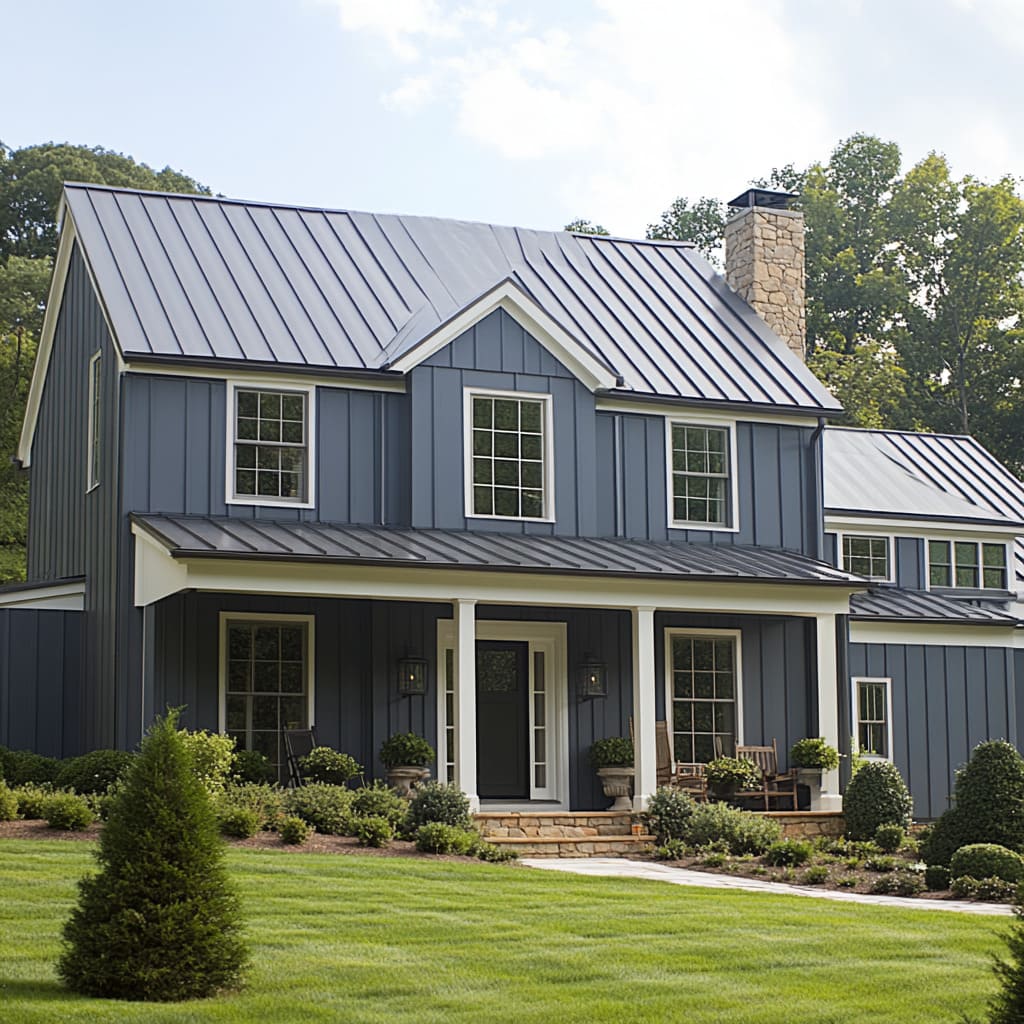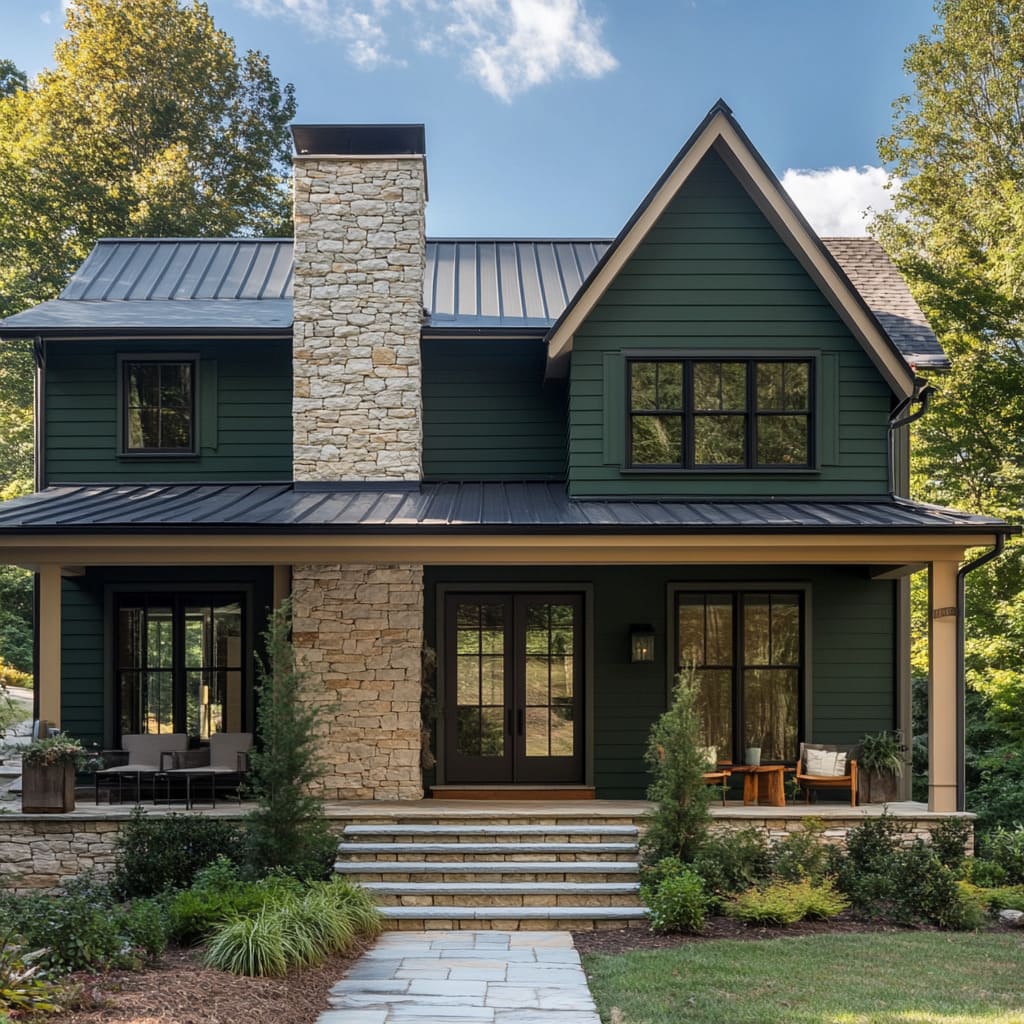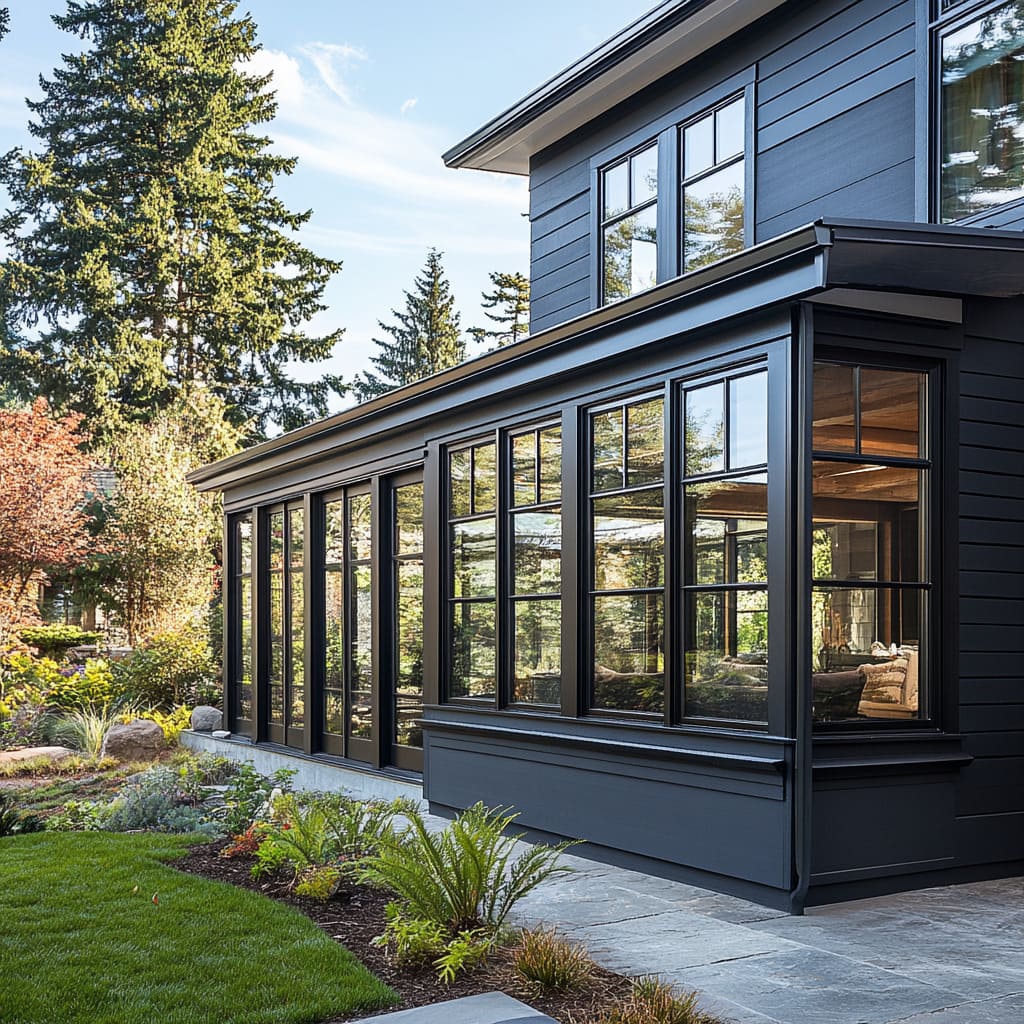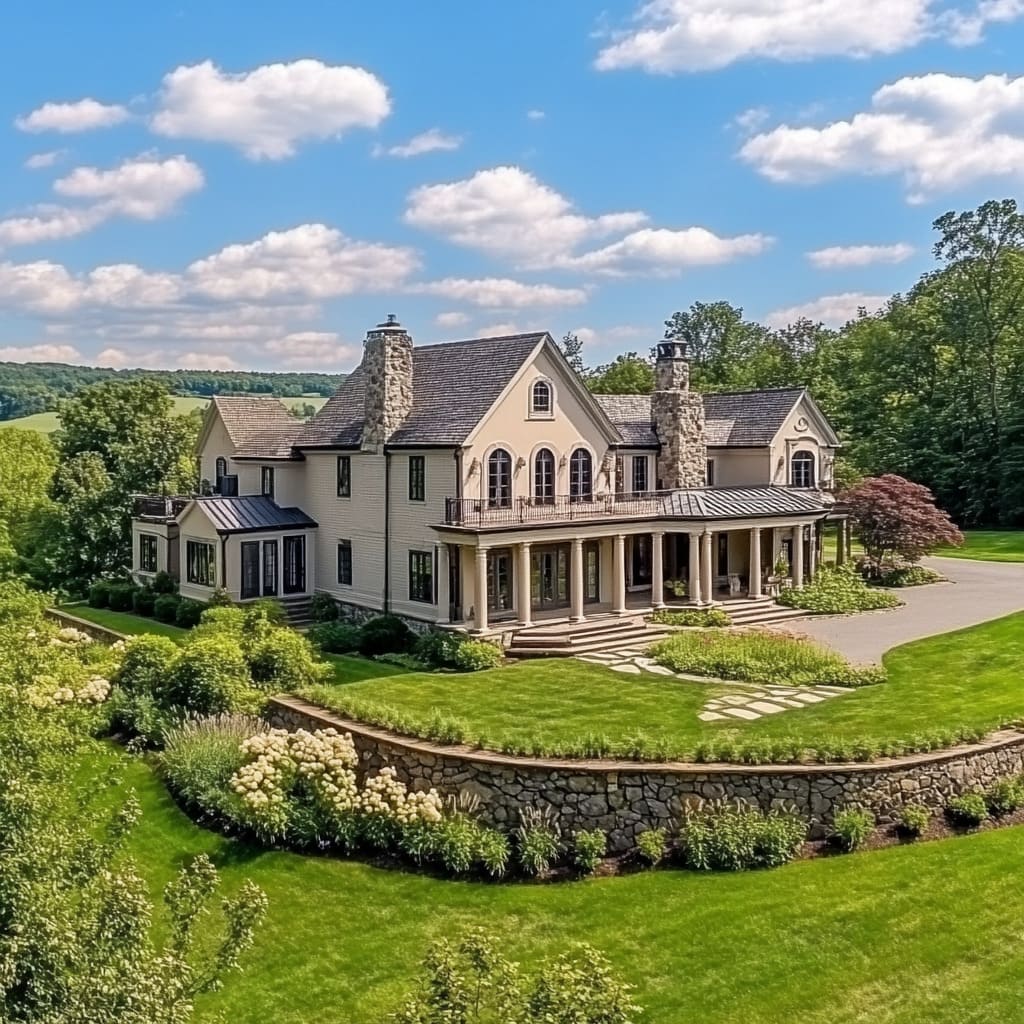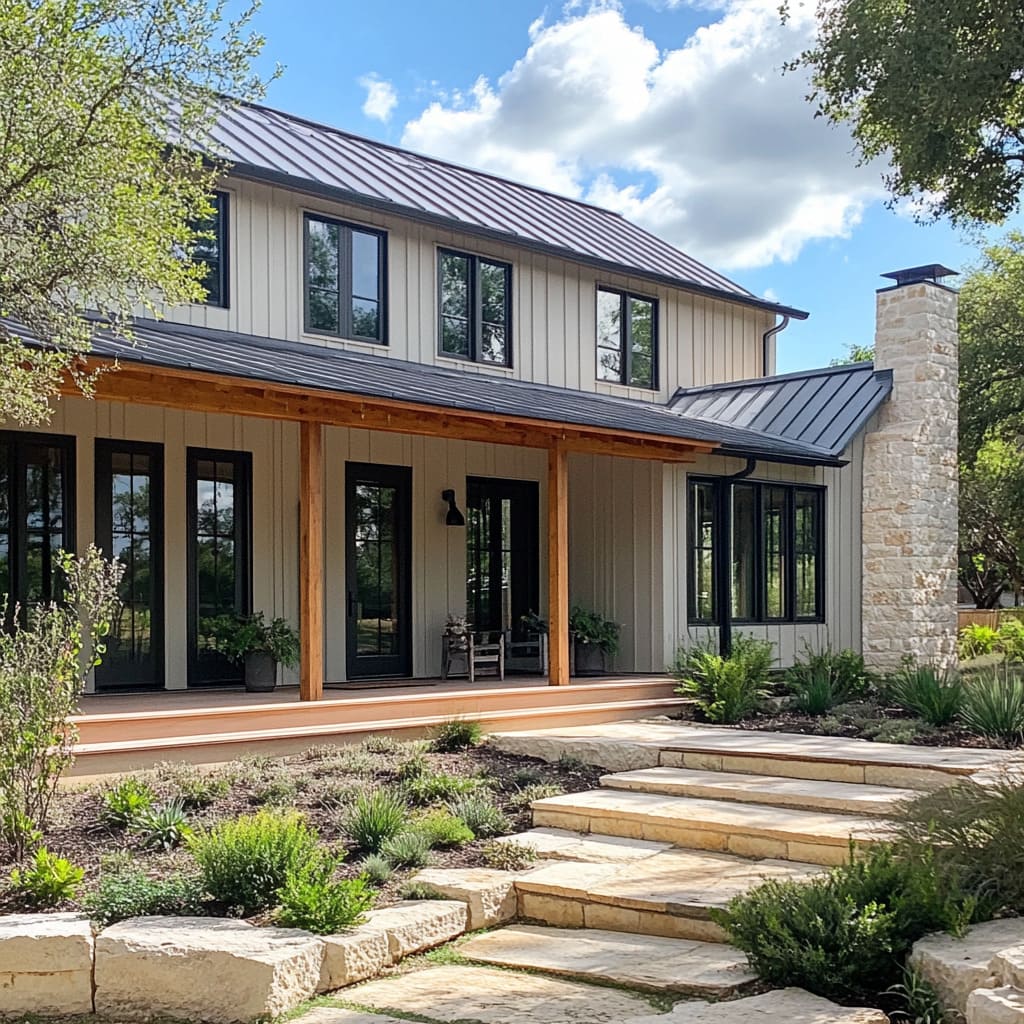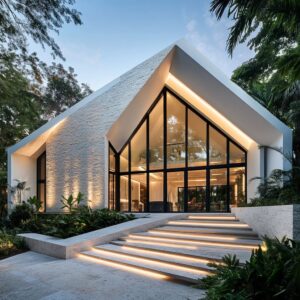Choosing the right exterior colors can completely change the way a home is perceived from the street. For farmhouse designs, in particular, the exterior palette is more than just a coat of paint—it’s a statement about style, personality, and connection to the surroundings.
The visual appeal of farmhouse exterior colors has the ability to create a welcoming and warm appearance while setting a home apart in its neighborhood.
Farmhouse aesthetics are uniquely rooted in tradition, often inspired by the simplicity and practicality of rural life. Yet, they have evolved to embrace a more refined and contemporary touch.
Today’s modern farmhouse exterior colors blend classic tones with contemporary contrasts, using natural materials and thoughtful accents to create designs that feel both timeless and fresh. Whether it’s the pairing of black and white for a bold contrast or earthy shades like taupe and sage green that harmonize with the environment, these palettes have gained popularity across a wide range of home styles.
With so many options available, selecting the right colors becomes an exciting opportunity to add character to your home while boosting its curb appeal. This article will guide you through inspiring ideas and tips to achieve a standout farmhouse exterior that reflects both traditional charm and modern trends.
What Makes Farmhouse Colors Stand Out?
Farmhouse designs have an undeniable charm, capturing the essence of both tradition and modern appeal. One of the defining features of these homes is their thoughtful use of color.
The balance between classic and contemporary hues is what makes farmhouse colors a timeless choice for homeowners seeking a perfect blend of warmth and sophistication.
The Balance Between Tradition and Modern Style
Farmhouse exterior paint colors are often rooted in tradition, inspired by the practical and simple palettes of rural homes. However, modern interpretations have brought a fresh perspective, combining heritage shades with innovative contrasts.
For example, pairing crisp white with striking black trim creates a clean yet dramatic look, while softer combinations like taupe and cream evoke a sense of subtle elegance. This duality of old and new allows farmhouse exteriors to remain relevant in both rural and urban settings.
Whether you’re aiming for a nostalgic countryside feel or a sleek, updated look, the right colors can bridge the gap between timeless charm and contemporary design.
The Power of Contrast and Earthy Palettes
Contrast is a powerful tool in farmhouse design. Light and dark pairings, such as charcoal siding with white trim, add depth and character to the home’s exterior.
On the other hand, earthy tones—like sage green, soft beige, and muted browns—create a more natural, inviting appearance. These palettes work especially well when the surrounding environment is taken into account, seamlessly blending the home into its landscape.
Natural colors not only enhance visual harmony but also create an emotional connection, making the home feel approachable and grounded. These tones draw inspiration from the surrounding scenery, whether it’s a wooded area, open farmland, or even a coastal backdrop.
The Role of Materials in Enhancing Color Choices
The beauty of farmhouse exterior paint colors is amplified by the textures and finishes of accompanying materials. Wood, for example, adds warmth and authenticity, making it a natural partner for earthy shades or bold contrasts.
Cedar beams, shutters, and porch columns are especially effective at highlighting the simplicity and sophistication of a well-chosen palette. Stone and metal elements can also elevate the overall look.
Stacked stone foundations or chimneys add a rugged, durable feel, while matte black or bronze roofing provides a sleek, modern edge. These materials enhance the depth of the color scheme, creating a cohesive and polished exterior.
By combining thoughtfully chosen colors with complementary materials, farmhouse exteriors achieve a look that feels both timeless and modern, capturing the attention of anyone who passes by.
Trends in Farmhouse Exterior Colors
Modern homeowners are redefining the way farmhouse exteriors look, bringing fresh and bold perspectives to classic designs. These trends are rooted in a deep appreciation for tradition but are elevated by contemporary elements, ensuring that farmhouse styles remain relevant in today’s diverse architectural landscape.
Whether it’s the balance of striking contrasts or the incorporation of organic tones, farmhouse exterior designs are evolving in exciting ways.
Reimagining Classic Palettes
While traditional farmhouse designs often leaned heavily on neutral and earthy tones, the modern take is far more dynamic. Black and white combinations, for instance, are dominating as the go-to choice for many.
This bold pairing not only emphasizes clean lines and structural details but also creates a dramatic visual impact that feels timeless and chic. At the other end of the spectrum, softer tones inspired by nature, such as sage green, taupe, and dusty blues, are making a strong comeback.
These palettes resonate with those looking to harmonize their homes with their surroundings, offering a fresh and grounded aesthetic.
The Rise of Contrast and Subtlety
The charm of farmhouse styles lies in their versatility. Bold contrasts, like deep charcoal siding with crisp white trim, add definition to exteriors, making architectural details pop.
These combinations work particularly well when paired with darker roofs or accent features like black-framed windows. On the other hand, nature-inspired tones create a more subtle elegance, ideal for blending into wooded or rural landscapes.
Materials That Complement Farmhouse Siding Colors
Trending materials play a crucial role in enhancing modern farmhouse siding colors. Matte metal roofing, for example, adds a sleek, understated shine that pairs beautifully with both bold and muted palettes.
It’s durable and perfect for achieving a modern edge without compromising the farmhouse’s rustic charm. Cedar accents, such as shutters, beams, and porch columns, are another favorite, adding warmth and texture to the overall design.
Meanwhile, whitewashed brick is becoming a popular choice for foundations and chimneys, offering a vintage yet contemporary touch that works seamlessly with a variety of color schemes.
Blending the Past with the Present
Today’s farmhouse exteriors are about more than just tradition—they reflect a blend of nostalgic elements and modern aesthetics. By pairing updated color schemes with thoughtful material choices, homeowners are transforming farmhouses into designs that feel authentic yet innovative, proving that classic and modern can coexist beautifully.
Designing with Your Surroundings in Mind
Choosing the right farmhouse exterior color involves more than just personal preference. The environment surrounding your home plays a critical role in determining what colors will look harmonious or stand out in the best way possible.
Whether your farmhouse sits in a rural, urban, or coastal setting, aligning the palette with its backdrop can enhance both its charm and its individuality.
Rural Settings: Blending into Nature
For farmhouses nestled in rural landscapes, colors that echo the natural surroundings often create the most striking results. Soft greens, taupes, and earthy tones work beautifully in these areas, complementing the greenery, soil, and open skies.
Sage green siding paired with white trim, for example, offers a subtle nod to the environment while maintaining a polished look.
Materials also play a significant role in rural settings. Cedar shutters or beams and stone accents tie the design to its surroundings.
These elements add depth and texture, making the home feel both intentional and connected to the land.
Urban Farmhouses: Making a Statement
In an urban environment, where homes are often closer together, farmhouse designs can stand out with bolder, well-balanced choices. Navy blue siding with crisp white trim is a popular option, offering sophistication without being overwhelming.
For a more contemporary touch, charcoal siding paired with natural wood accents strikes a perfect balance of modern and rustic.
The key is to create a contrast that feels refined yet approachable. Bold choices like these work well when accented with clean lines, metal roofing, or black-framed windows, ensuring the design remains cohesive within a more structured urban landscape.
Coastal Inspiration: Light and Airy Palettes
Coastal farmhouses call for palettes inspired by the ocean and sky. Light blues, grays, and soft whites dominate here, creating a calming and fresh aesthetic.
These shades reflect the natural light beautifully, making the home feel airy and inviting. In coastal settings, it’s also common to incorporate materials like whitewashed brick or copper accents for a subtle but impactful finish.
These details enhance the overall design while staying true to the farmhouse style.
Standing Out While Staying Balanced
For homeowners looking to make a statement, bold tones like deep navy or rich charcoal can elevate the farmhouse aesthetic, no matter the setting. The trick is to balance these choices with neutral trim or natural accents to avoid overpowering the design.
For instance, pairing dark siding with light wooden porch columns or stone bases ensures the colors feel grounded and approachable.
Ultimately, designing with your surroundings in mind creates a look that feels tailored to its environment while showcasing the individuality of your home. A thoughtful farmhouse exterior color palette can make your home a standout piece of architecture that also feels perfectly at home in its setting.
Using Texture and Accents to Elevate Color Palettes
Farmhouse design goes beyond selecting paint; it’s about creating depth and character through the thoughtful use of materials and accents. While farmhouse exterior colors form the foundation of the design, elements like wood, stone, and metal bring these colors to life, adding texture and dimension that paint alone can’t achieve.
Wood: Warmth and Authenticity
Wood is a staple in farmhouse designs for good reason—it’s versatile and instantly adds warmth to any exterior. Natural cedar beams, shutters, and porch columns not only complement earthy tones like sage green, taupe, or greige but also soften bolder palettes like navy or black siding.
The organic texture of wood balances modern lines with rustic charm, creating a harmonious blend that feels timeless and inviting. Using reclaimed or weathered wood can further enhance the farmhouse aesthetic, giving the exterior a sense of history and character.
Whether it’s through a wooden front door, horizontal siding, or decorative gables, wood is an essential material for farmhouse homes.
Stone: Rugged Elegance
Stone details, whether in the form of stacked foundations, chimneys, or entryway pillars, add a rugged yet refined quality to farmhouse exteriors. Natural stone pairs exceptionally well with softer palettes like light gray or cream, anchoring the design with texture and durability.
For homeowners leaning toward darker siding, such as charcoal or deep green, stone accents offer a striking contrast that elevates the overall look. The interplay between smooth siding and the rough texture of stone creates a dynamic design that feels both polished and grounded.
Steel: Modern Meets Rustic
Metal accents are gaining popularity in modern farmhouse designs, with matte finishes leading the charge. Steel roofing in shades of black, bronze, or galvanized gray provides a sleek, minimalist contrast to natural materials like wood and stone.
Weathered steel planters or accent roofs over bay windows can also add a subtle industrial edge without overpowering the home’s rustic charm. Incorporating metal into light-toned designs—such as cream siding with soft white trim—adds a contemporary touch while blending seamlessly with the farmhouse’s overall aesthetic.
Accents That Define Style
Small details can make a big impact. Porch columns, for instance, frame the entryway and set the tone for the home’s design.
Thick wooden columns stained in warm tones complement earthy color schemes, while slimmer painted ones can enhance modern, minimalist designs. Shutters, whether they are functional or decorative, can also add depth.
Black shutters pop against white or beige siding, while stained wood versions provide a natural touch against lighter backdrops. Trim plays a similar role, acting as a frame for the home’s exterior and highlighting architectural details.
Creative Use of Copper and Brick
Copper accents are another way to add interest to farmhouse designs. Whether through light fixtures, guttering, or hardware, copper offers a warm metallic glow that pairs beautifully with both light and dark palettes.
Over time, its natural patina adds even more charm and depth. Whitewashed brick is another standout feature for farmhouse exteriors, especially when paired with softer colors like lavender-gray or sandstone beige.
The texture of brick adds a vintage feel that balances well with contemporary elements like board-and-batten siding or sleek window frames.
A Cohesive Design
By combining textures like wood, stone, and metal with well-chosen farmhouse exterior colors, homeowners can create a visually engaging exterior that feels complete. These materials work together to enhance the depth and richness of the color palette, resulting in a design that not only looks beautiful but also feels connected to its environment.
It’s this thoughtful layering of elements that truly elevates a farmhouse exterior into something unforgettable.
The Role of Neutral Tones and Bold Contrasts
When it comes to farmhouse design, the colors you choose can shape the entire character of your home. Neutral tones and bold contrasts serve as foundational elements in creating visually compelling exterior color schemes for farmhouses.
From soft backdrops to striking focal points, these combinations bring depth and personality to a home while maintaining its connection to the farmhouse style.
Neutral Tones: The Perfect Backdrop
Neutral shades like greige, beige, and soft gray have long been favorites for farmhouse exteriors. Their understated appeal makes them a versatile choice, allowing other design elements—like shutters, doors, and landscaping—to shine.
These tones are especially effective in creating a calming and cohesive look, making them ideal for homes in rural or wooded areas where a subtle harmony with the environment is desired. Greige, a balanced mix of gray and beige, is particularly popular for its ability to lean warm or cool depending on the accents used.
Pairing greige siding with crisp white trim provides a classic look that feels both fresh and timeless. Beige adds warmth and works beautifully with earthy tones or natural wood features like porch columns and beams.
Soft gray, often associated with coastal or modern farmhouse designs, offers a clean and sophisticated base that complements a wide range of accent colors.
Bold Contrasts: Striking Combinations That Stand Out
For homeowners looking to make a statement, high-contrast combinations are the way to go. Black siding paired with warm wood accents is a striking example of how bold contrasts can enhance a farmhouse’s visual appeal.
The deep, matte finish of black siding highlights the natural texture of wood, creating a dramatic yet grounded aesthetic.
Another powerful combination is charcoal gray siding with white trim. This pairing balances boldness with brightness, allowing architectural details like dormer windows or board-and-batten siding to take center stage.
Accents such as metal roofing or stone foundations can further enhance the depth of these contrasts, ensuring the home feels layered and inviting.
Balancing Bold and Subtle Elements
The key to a successful design lies in balance. Bold siding colors, like navy blue or forest green, can create a captivating exterior when paired with softer, complementary trim.
For instance, navy siding with warm white trim and natural wood accents strikes the perfect balance between richness and simplicity. Similarly, dark green siding framed by beige or taupe trim offers an earthy yet refined look that feels rooted in tradition while embracing modern trends.
Using softer tones for trim and accents helps ground bolder color choices, ensuring the overall design doesn’t feel overwhelming. Elements like window frames, doors, and shutters can also play a role in tying the look together, either by echoing the siding color or providing a subtle contrast.
Achieving a Cohesive Look
Whether you’re drawn to the timeless appeal of neutrals or the dramatic impact of bold contrasts, the most important factor is cohesion. Each color and material should work together to enhance the farmhouse’s charm while reflecting its surroundings and the homeowner’s personal style.
Thoughtfully chosen exterior color schemes for farmhouses have the power to transform a home, creating an exterior that feels inviting, unique, and beautifully balanced.
Tips for Combining Modern and Rustic Aesthetics
Creating the perfect farmhouse exterior often involves blending modern sophistication with rustic charm. Thoughtful combinations of contemporary palettes and traditional materials allow homeowners to achieve a design that feels both fresh and timeless.
By carefully selecting exterior paint colors for farmhouse designs and pairing them with classic elements, you can strike a balance that enhances both style and functionality.
Merging Contemporary Palettes with Farmhouse Charm
Modern farmhouse design is rooted in a respect for tradition, but it embraces clean lines and bold colors that appeal to today’s tastes. Contemporary hues like charcoal gray, deep navy blue, or even matte black add a striking edge to farmhouse exteriors, offering a sleek contrast to their rustic foundations.
To maintain a farmhouse feel, these modern colors should be paired with softer, warmer accents. For instance, midnight blue siding complemented by cedar beams or natural wood shutters creates a cozy yet refined look.
Similarly, charcoal gray exteriors paired with lighter, earthy tones in trim or window frames ensure the home retains its welcoming charm.
Pairing Modern Colors with Traditional Materials
The key to a successful design lies in the thoughtful pairing of colors and textures. Cedar beams, a farmhouse staple, offer warmth and an organic feel that grounds bolder, modern palettes.
Imagine a home with black board-and-batten siding accented by cedar porch columns—the juxtaposition of contemporary and rustic elements creates a striking yet balanced look. Stonework, another traditional material, works beautifully with modern color schemes.
A foundation of stacked stone can add texture and dimension to navy blue or charcoal exteriors while emphasizing the farmhouse’s connection to the land. For lighter palettes, such as greige or cream, stone accents introduce subtle depth without overwhelming the overall design.
Modernizing Rustic-Inspired Homes with Minimalistic Accents
For homeowners who lean toward simplicity, minimalistic accents can modernize rustic-inspired homes while maintaining their character. Consider replacing ornate details with sleeker alternatives: matte black metal fixtures, streamlined window frames, or understated railings.
These elements create a clean, cohesive appearance that highlights the beauty of the farmhouse without unnecessary distractions. Trim and shutters can also be reimagined in modern designs.
Instead of opting for traditional contrasting colors, consider using a monochromatic palette with subtle variations in texture. For example, pairing slightly darker trim with the main siding color can create a modern edge while still respecting the farmhouse aesthetic.
Achieving a Harmonious Design
Ultimately, merging modern and rustic elements is about balance. By carefully selecting materials, colors, and accents, you can create a farmhouse exterior that feels both timeless and current.
Whether you’re drawn to bold shades or understated neutrals, the right exterior paint colors for farmhouse designs will help you achieve a cohesive look that celebrates the best of both worlds. Thoughtful design ensures your home makes a lasting impression while staying true to its roots.
Practical Advice for Choosing Colors
Selecting the perfect color palette for your farmhouse exterior can feel like a big decision, but with the right tools and strategies, it becomes an exciting opportunity to create a home that reflects your personal style. Modern homeowners are increasingly drawn to modern farmhouse color schemes, blending timeless charm with contemporary appeal.
To ensure you’re making the best choices, it’s essential to consider lighting, visualization tools, and budget-friendly options.
Test Colors in Real Lighting Conditions
The way colors appear on a swatch or in a store may differ drastically from how they look on your home’s exterior. Natural lighting, shadows, and the time of day can all influence the appearance of your chosen colors.
Before committing to a full repaint, it’s a good idea to test samples on different areas of your house, such as a sunlit side, a shaded corner, and near architectural features like windows or columns. Small test patches allow you to observe how the color interacts with the surroundings and complements materials like wood, stone, or metal.
Pay attention to how the hues evolve throughout the day—what might seem vibrant in the morning light can feel muted by evening.
Visualize Combinations with Tools and Samples
If you’re feeling unsure about which colors to choose, technology can be a helpful ally. Online design tools and rendering software let you experiment with different modern farmhouse color schemes, offering a preview of how your home will look with various palettes.
Many platforms allow you to upload a photo of your house and try out combinations of siding, trim, and accent colors in a virtual environment. For those who prefer a hands-on approach, creating a sample board can be just as effective.
Gather small pieces of your chosen materials—wood, stone, or metal—and paint swatches to assemble a cohesive representation of your design. This tactile process gives you a chance to see how textures and colors work together before making a final decision.
Budget-Friendly Options for Updating Colors
Revamping your farmhouse’s exterior doesn’t have to break the bank. If you’re working within a budget, consider starting with smaller updates rather than a full-scale repaint.
Repainting shutters, trim, or doors can create a noticeable impact with minimal cost and effort. These accents often define the character of a home and can refresh the overall look without a significant investment.
For those who are comfortable with DIY projects, painting is one of the most approachable home improvements. With proper preparation and quality materials, you can tackle areas like a porch or fence to bring in complementary tones.
Alternatively, hiring a professional for high-visibility areas, such as the main siding, ensures a flawless finish while keeping labor costs focused on key elements.
Bringing It All Together
Choosing the right exterior colors is about more than aesthetics—it’s about creating a welcoming and cohesive design that reflects your personality and the character of your home. By testing colors in natural light, using visualization tools, and starting with budget-friendly updates, you can confidently select a palette that will enhance your farmhouse’s charm and longevity.
With a little planning and creativity, your home will stand out while feeling perfectly in tune with its surroundings.
Mistakes to Avoid When Choosing Colors
Choosing the right exterior colors for your farmhouse is an exciting step in creating a home that feels cohesive and inviting. However, there are common pitfalls that can detract from the overall look and longevity of your design.
From mismatched materials to overlooked features, avoiding these mistakes will ensure your modern farmhouse exterior paint choices make the impact you’re looking for.
Avoid Overloading with Too Many Colors
One of the most frequent missteps in exterior design is using too many colors. While it’s tempting to incorporate multiple shades for variety, an overloaded palette can create a cluttered and chaotic appearance.
A good rule of thumb is to stick to three main colors: one for the siding, one for the trim, and an accent color for shutters, doors, or smaller features.
For example, pairing charcoal gray siding with crisp white trim and a natural wood door creates a harmonious and visually balanced look. Introducing additional colors, such as a brightly painted porch railing or contrasting shutters, might dilute the effect and detract from the farmhouse’s clean aesthetic.
Don’t Overlook the Roof, Porch, or Landscape
When planning your farmhouse color palette, it’s crucial to consider the broader context. The roof, porch, and surrounding landscape all play a role in how your home’s colors are perceived.
A mismatched roof or neglected landscaping can disrupt an otherwise well-thought-out design. For instance, if your roof features warm tones like brown or terracotta, opt for siding colors that complement those hues, such as beige, taupe, or greige.
Similarly, a porch with natural wood elements might inspire trim or shutter colors that tie the design together. Landscaping is another key factor—lush greenery can enhance earthy tones, while stone pathways or fencing can accentuate bolder, modern shades.
Factor in Durability and Maintenance
Choosing colors without considering the durability and maintenance of materials can lead to frustration down the road. Some colors and finishes require more upkeep than others, particularly in regions with extreme weather conditions.
For example, lighter siding colors like white or cream may show dirt and grime more easily, while darker hues like navy blue might fade faster under constant sunlight. Additionally, the materials used in your home’s construction can affect how well your paint adheres and ages.
Wood siding may need more frequent repainting than fiber cement or vinyl, so selecting high-quality paint formulated for your specific material is essential. For a modern farmhouse exterior paint project, prioritize finishes that offer long-lasting protection against fading, peeling, and weathering.
The key to a stunning farmhouse exterior is thoughtful planning. Avoid the temptation to overload your palette, and instead focus on a cohesive design that considers all elements of your home, from the roof to the landscaping.
By factoring in the durability and maintenance of your materials, you can ensure your farmhouse’s exterior remains beautiful and welcoming for years to come. Small details make a big difference, and avoiding these common mistakes will help your design shine.
Inspiring Farmhouse Makeover Stories
Transforming a farmhouse exterior with the right colors can breathe new life into a home, making it a standout in its neighborhood while retaining its welcoming charm. Homeowners across various regions have embraced creative exterior farmhouse color schemes, resulting in stunning before-and-after transformations that prove the power of thoughtful design.
A Bold Contrast Brings New Life to a Traditional Farmhouse
One homeowner faced the challenge of updating an aging farmhouse with faded white siding and mismatched trim. By choosing a striking black-and-white palette, they completely revitalized the home’s appearance.
The siding was painted a crisp white, while the trim and shutters were given a matte black finish. To add warmth and natural texture, cedar columns were installed on the porch.
The result was a modern take on a classic design, achieving both elegance and simplicity. Before the update, the house blended into the background, but the new bold contrast created an inviting and memorable facade.
The clean lines of the black-and-white combination not only improved curb appeal but also highlighted the architectural details that had previously gone unnoticed.
A Cozy Rural Retreat with Earthy Tones
In a wooded setting, another homeowner embraced earthy tones to blend their farmhouse seamlessly with the surrounding landscape. The outdated beige exterior was transformed with sage green siding and cream trim.
To tie the design together, natural stone accents were added to the foundation, and the front door was painted a deep brown to complement the overall palette. This color scheme created a calm and cohesive look, giving the farmhouse a cozy, grounded feel.
The before-and-after transformation was subtle yet impactful, proving that strategic updates can harmonize a home with its environment while enhancing its aesthetic appeal.
Modern Elegance with Navy and Wood Accents
For a suburban farmhouse in need of a contemporary update, the homeowners selected navy blue siding paired with white trim and warm wood accents. The front door and porch columns were upgraded to natural cedar, adding texture and depth to the design.
Black metal light fixtures and a sleek metal roof completed the look, creating a polished yet welcoming exterior. Before the makeover, the house lacked character and felt outdated.
The new design not only increased curb appeal but also gave the home a distinct personality. The combination of modern colors with rustic materials struck the perfect balance, making the farmhouse both timeless and trendy.
General Insights into Embracing Trends
These inspiring makeovers highlight how homeowners are using color to redefine their farmhouses. Whether blending into natural surroundings or making a bold statement, strategic choices in exterior farmhouse color schemes have proven transformative.
By pairing modern palettes with traditional elements, these updates showcase the versatility of farmhouse design while reflecting the individuality of the homeowner. Each transformation reinforces the idea that the right color scheme can do more than improve a home’s appearance—it can enhance its connection to its environment and create a lasting impression.
For those considering a makeover, these stories serve as a reminder that thoughtful planning and a touch of creativity can turn any farmhouse into a standout space.
Conclusion: Farmhouse Colors That Leave a Lasting Impression
Farmhouse designs have a timeless appeal, and the right farmhouse exterior colors can amplify that charm, making homes both welcoming and stylish. Whether embracing classic combinations like white and black or exploring earthy tones and bold contrasts, these color palettes offer endless opportunities to transform a home’s appearance.
The beauty of farmhouse color schemes lies in their versatility. They can reflect the rustic simplicity of a rural setting or the sleek sophistication of a modern urban neighborhood.
By carefully selecting hues that harmonize with natural surroundings and architectural elements, homeowners can create exteriors that feel cohesive and authentic. The addition of thoughtful materials, such as wood, stone, or metal, further enhances the design, adding depth and texture to the palette.
Ultimately, choosing farmhouse exterior colors is about more than just aesthetics—it’s about expressing personal style while honoring the character of the home. A well-planned color scheme can elevate curb appeal, increase value, and create a space that feels as inviting as it looks.
For those planning their next project, timeless yet contemporary options provide the perfect balance, ensuring the farmhouse retains its charm while embracing modern trends. Your home is a reflection of you, and with the right colors, it can leave a lasting impression on everyone who sees it.
Take inspiration from the ideas shared, and let your farmhouse exterior stand out in the best possible way.


